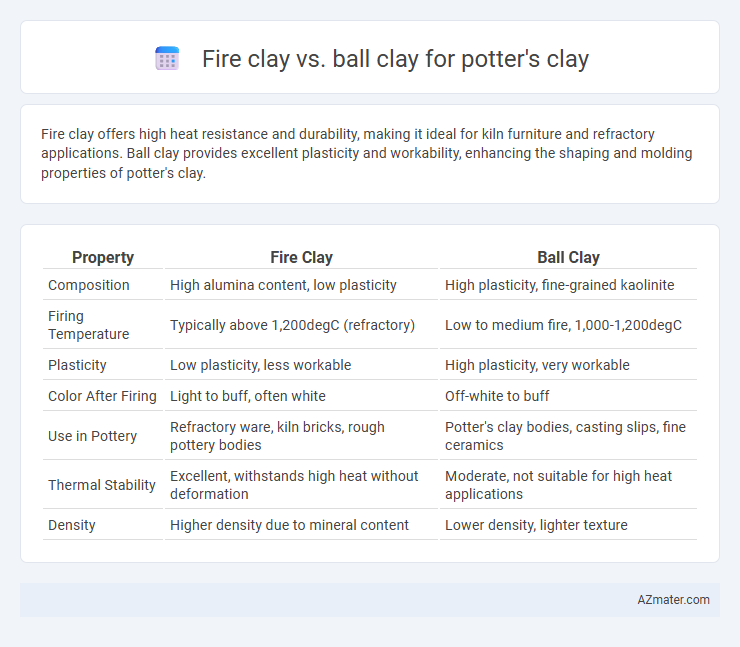Fire clay offers high heat resistance and durability, making it ideal for kiln furniture and refractory applications. Ball clay provides excellent plasticity and workability, enhancing the shaping and molding properties of potter's clay.
Table of Comparison
| Property | Fire Clay | Ball Clay |
|---|---|---|
| Composition | High alumina content, low plasticity | High plasticity, fine-grained kaolinite |
| Firing Temperature | Typically above 1,200degC (refractory) | Low to medium fire, 1,000-1,200degC |
| Plasticity | Low plasticity, less workable | High plasticity, very workable |
| Color After Firing | Light to buff, often white | Off-white to buff |
| Use in Pottery | Refractory ware, kiln bricks, rough pottery bodies | Potter's clay bodies, casting slips, fine ceramics |
| Thermal Stability | Excellent, withstands high heat without deformation | Moderate, not suitable for high heat applications |
| Density | Higher density due to mineral content | Lower density, lighter texture |
Introduction to Potter's Clay Types
Potter's clay primarily consists of fire clay and ball clay, each serving distinct purposes in ceramics due to their unique properties. Fire clay is refractory and withstands high temperatures, making it ideal for kiln linings and heavy-duty pottery, while ball clay offers fine particle size and plasticity essential for shaping and detailed work. Understanding the differences in silica, alumina, and plasticity levels between fire clay and ball clay allows potters to select appropriate materials for durability and formability in their creations.
What is Fire Clay?
Fire clay is a highly refractory material composed primarily of kaolinite with notable alumina content, enabling it to withstand extreme temperatures above 1,500degC without deforming, making it ideal for kiln linings and pottery that requires high firing temperatures. Compared to ball clay, which is softer and contains higher plasticity with more organic matter, fire clay has lower plasticity but boasts superior heat resistance and structural integrity. Potters choose fire clay when durability and thermal resistance are critical factors for their ceramic projects, particularly for stoneware and porcelain firing.
What is Ball Clay?
Ball clay is a highly plastic, fine-grained clay composed mainly of kaolinite, mica, and quartz, valued for its smooth texture and excellent binding properties in pottery. It enhances the strength and plasticity of potter's clay, making it easier to shape and reducing shrinkage during drying and firing. Unlike fire clay, which is refractory and used for high-temperature applications, ball clay provides essential plasticity and workability in ceramic bodies.
Key Mineral Composition Differences
Fire clay primarily contains high amounts of kaolinite and alumina, offering exceptional heat resistance and structural strength ideal for kiln furniture and firebricks. Ball clay is rich in kaolinite, mica, and quartz, with higher plasticity and fine particle size, which enhances workability and plastic strength in potter's clay formulations. The mineral composition contrast results in fire clay's refractory properties versus ball clay's superior plasticity and forming capabilities in ceramic production.
Plasticity: Fire Clay vs Ball Clay
Fire clay exhibits lower plasticity compared to ball clay, making it less workable but more resistant to high temperatures and thermal shock in pottery. Ball clay boasts high plasticity due to its fine particle size and mineral composition, enhancing its moldability and green strength in ceramic bodies. Combining fire clay with ball clay balances plasticity and durability, optimizing the overall performance of potter's clay.
Firing Temperatures and Performance
Fire clay withstands higher firing temperatures, typically between 1200degC and 1400degC, making it ideal for stoneware and refractory applications due to its excellent thermal stability and durability. Ball clay fires at lower temperatures, around 1000degC to 1150degC, offering superior plasticity and workability, which enhances shaping and forming in pottery but produces more porous and less heat-resistant ceramics. Choosing between fire clay and ball clay depends on the desired firing range and final product performance, with fire clay suited for high-temperature strength and ball clay favored for fine detail and smooth texture.
Workability and Forming Qualities
Fire clay offers excellent workability due to its high alumina content, providing good plasticity and resistance to cracking during forming. Ball clay boasts superior plasticity and fine particle size, making it highly moldable and ideal for intricate shapes requiring smooth surfaces. Both clays enhance potter's clay blends, with ball clay improving formability and fire clay contributing durability and thermal stability.
Typical Applications in Pottery
Fire clay, known for its high refractory properties and resistance to thermal shock, is typically used in pottery requiring durability and heat resistance, such as kiln furniture, refractory bricks, and sculptural ceramics. Ball clay, characterized by its plasticity and fine particle size, is primarily employed in pottery for improving workability and strength in casting bodies, glazing, and fine art ceramics. Potters often blend fire clay and ball clay to optimize both thermal resilience and plasticity for versatile ceramic applications.
Mixing Fire Clay and Ball Clay: Benefits & Considerations
Mixing fire clay and ball clay in potter's clay enhances workability by balancing fire clay's high refractory properties with ball clay's plasticity and plastic strength, resulting in a more durable and pliable clay body. Fire clay provides thermal stability and resistance to high temperatures, while ball clay contributes fine particle size and smooth texture, improving the clay's overall plasticity and drying properties. Consideration should be given to the proportions used, as excessive fire clay may reduce plasticity, and too much ball clay can affect the clay's firing shrinkage and heat resistance.
Choosing the Right Clay for Your Pottery Project
Fire clay and ball clay differ significantly in plasticity and firing properties, making the choice crucial for pottery projects. Fire clay offers high refractory qualities and lower plasticity, ideal for functional ware requiring heat resistance, while ball clay provides excellent plasticity and workability, perfect for intricate shaping and fine details. Selecting the right clay depends on your project's durability needs and desired texture, with fire clay suited for sturdy, heat-resistant pottery and ball clay favored for smooth, detailed ceramics.

Infographic: Fire clay vs Ball clay for Potter's clay
 azmater.com
azmater.com